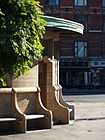Trianglen, Copenhagen

Trianglen (literally "The Triangle") is a central junction and public space in the Østerbro district of Copenhagen, Denmark. Five streets meet in the junction: Blegdamsvej, Øster Allé, Østerbrogade, Nordre Frihavnsgade and Odensegade. Trianglen will be a station on the City Circle Line of the Copenhagen Metro.
Lille Trianglen (literally "Little Triangle") is located some 400 metres to the south, along Østerbrogade. It is the junction of Østerbrogade, Dag Hammarskjölds Allé, Classensgade, Øster Farimagsgade and Østergade.
History
.jpg)
The hospital Vartov was from 1630 located at the site. Its fortified building was part of Christian IV's defense of Copenhagen. The East Road passed through the complex which consisted of four wings surrounded by ramparts and moats. The building was destroyed during the Swedish siege of Copenhagen in 1658 and Vartov subsequently moved to its current home on Vester Voldgade in 1665.[1][2]

The site's importance as a junction outside the Eastern City Gate was consolidated when Øster Allé and Blegdamsvej was expanded in 1750.
In the 19th century, Trianglen was a hub for carridges which drove copenhageners north to Jægersborg Dyrehave.[3] Strandvejen Steam Tramway Company opened a route between Trianglen and Klampenborg in 1884 but it was discontinued in 1892.[4]
Notable buildings
Two buildings bear testament to Trianglen's history as a hub for trams. The building in the middle of the square is a former waiting room built for the tramways in 1907. It was designed by Peder Vilhelm Jensen-Klint and has variously been referred to as "The Bee", "The Turtle and "The soup bowl"" due to its shape. It was listed in 1986.[5] The building at 132 Blegdamsvej is a former tram depot, Blegdamsvej Remisse (Blegdamsvej Depot), built by Copenhagen Tramways in connection with the electrification of the tramways in 1901 to a design by Vilhelm Friederichsen. It was decommissioned in 1964 in commection with the discontinuation of Line 15 and materiel was transferred to Svanemøllen Depot. The building was converted into a community centre and sports venue in the 1980s.[6]
-

The Bee: Outdoor seating
-

The Bee detail
-

The Bee: Detail
See also
References
- ↑ "1630" (in Danish). Selskabet for Københavns Historie. Retrieved 2013-09-17.
- ↑ "Trafikkaos på Trianglen" (in Danish). Berlingske. Retrieved 2013-09-17.
- ↑ "Historien" (in Lægeforeningens Boliger). AOK. Retrieved 2013-09-17.
- ↑ "1883" (in Danish). Selskabet for Københavns Historie. Retrieved 2013-09-17.
- ↑ "Sag: Bien" (in Danish). Kulturstyrelsen. Retrieved 2013-09-17.
- ↑ Remise. "Sporvognsremiser i København" (in Danish). sporvej.dk. Retrieved 2013-09-20.
External links
| Wikimedia Commons has media related to Trianglen. |
| |||||||||||||||||||||||||||||
Coordinates: 55°41′57″N 12°34′38″E / 55.69917°N 12.57722°E